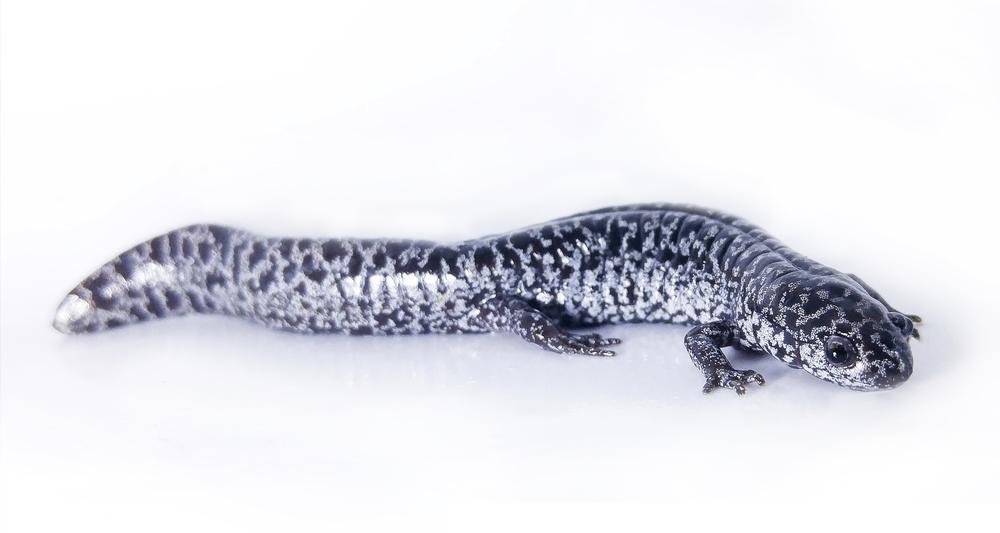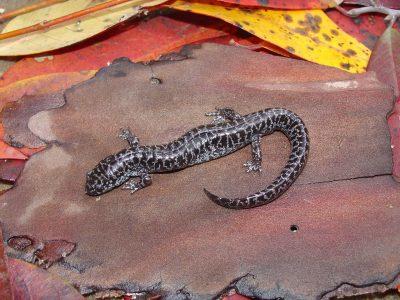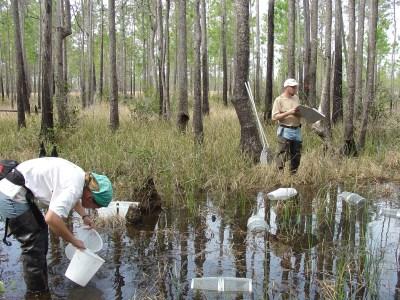
Section Branding
Header Content
Could Frosted Flatwoods Salamander Be Georgia's Climate Change Canary?
Primary Content

Laura Corley, The Current
In mud puddles located on a sprawling military post in Coastal Georgia where tanks rumble and soldiers train for war, the last of a threatened species clings to life.
Fort Stewart Army Base is home to the only remaining documented colony of frosted flatwoods salamanders in Georgia; The only other two groupings of the black-bodied amphibians with mottled bands of silvery white anywhere else on Earth are in Florida, although they once inhabited thousands of wetlands along the East Coast and the Gulf of Mexico.
Amphibians have been around for millions of years but scientists have documented a sharp decline worldwide over the past few decades. That worries herpetologists, scientists who study reptiles and amphibians, because vanishing amphibian populations are a likely sign that Earth is becoming less inhabitable.
“They’re indicator species and what that means is they’re more sensitive to the environment,” said Elise Bennett, reptile and amphibian staff attorney for The Center for Biodiversity. “So when bad changes happen, they’re going to feel it first, perhaps before we notice it ourselves.”

A rare piece of good news: the frosted flatwoods on Fort Stewart are breeding this year. The species has been decimated by droughts, prescribed burning that is out-of-season and a disappearing habitat that makes it difficult to multiply.
Several surveys at the military base are underway and continuing through March. The surveys are a collaboration between the U.S. Army and environmentalists. Even so, efforts to ensure the species’ survival on paper are at the mercy of a slow-moving federal bureaucracy.
In January, a group of environmentalists led by Bennett filed a lawsuit seeking to push one branch of the federal government to move forward. The lawsuit seeks to compel the U.S. Fish and Wildlife Service to publish plans intended to guide recovery plans for the salamander.
Bennett said the plans, which took years to create, have been completed but not published.
“We don’t know what’s holding them up, but the delay is meaningful,” she said.
From Rare To Endangered
Flatwoods salamanders have been on the radar of nature conservationists since the early 1980s, but scientists have struggled to make them a priority for the federal agencies.
In 1992, The Biodiversity Legal Foundation sued the federal government on behalf of several hundreds of plants and animals. The lawsuits and petitions resulted in more than 400 species being given protections under the Endangered Species Act listings, including the flatwoods salamanders. The foundation later merged with The Center for Biodiversity.
The state of Georgia listed the flatwoods salamander as a rare and protected species in 1994, though the law has no effect on private land owners. The species received protections under the federal Endangered Species Act in 1999.
Even so, many known populations were wiped out by severe droughts in the early 2000s.

In 2009, biologists discovered there were actually two types of flatwoods salamanders: frosted and reticulated. That meant that two species were in much dire straits than previously thought.
Both are on the brink of extinction.
In 2019, the U.S. Fish and Wildlife Service recommended reclassifying the status of the salamanders from threatened to endangered, but then the wheels of this federal bureaucracy stopped moving. It’s not clear why the agency has not published the recovery plans to identify actions necessary to save the species.
Mark Mandica is among biologists who helped author the plan.
“I worked on that recovery plan – we worked very hard on it – and it’s been sitting on someone’s desk for quite a while,” said Mandica, executive director and cofounder of the Amphibian Foundation, a nonprofit that helps protect amphibians and their habitats.
The foundation helps survey Fort Stewart and works with the Georgia Department of Natural Resources and the University of Georgia on amphibian conservation projects.
In an effort to help save the dwindling population, Mandica has been raising frosted flatwoods salamander larvae in captivity at the foundation’s lab in Atlanta. There are about 400 frosted flatwoods salamanders living in man-made mesocosms. They range in age but the oldest are a pair of 6-year-olds.
The average lifespan is unknown.
“There are relatives that live, you know, 25 years,” Mandica said. “So it’s possible that they live that long. But we just don’t know so much is unknown about this species and we have this opportunity to learn about them while we try to conserve them.”
Most of the foundation’s captive species there come from lab-hatched eggs collected from the Apalachicola National Forest in 2018. Others were collected as larvae in the wetlands of Fort Stewart and St. Marks National Wildlife Refuge as early as 2015, Mandica said.
So far, none of the adult frosted flatwood salamanders have reproduced. However, Mandica said there’s still some time left this breeding season and he remains hopeful.
He hopes the publication of the federal recovery plan will “give some more teeth to their protection” and possibly result in more resources for scientific research.
Logging Shrinks Longleaf Pine Forests
Since the early 20th century, heavy logging has reduced longleaf pine forests by 97 percent of their original range in the southeastern coastal plain, said Daniel Sollenberger, state herpetologist for the Georgia Department of Natural Resources.
About 700,000 acres of land in the coastal plains is owned by Rayonier Inc., a global timberland real estate investment trust that grows loblolly, slash and longleaf pine forests used primarily for pulpwood and sawtimber. Production is at capacity amid an increasing demand for exports to China and India, according to the company’s website.
The success of the company has sparked ire among conservationists who see its business as detrimental to Coastal Georgia’s imperiled species, such as the gopher frog, the striped newt, the red-cockaded woodpecker and the eastern indigo snake.
Rayonier, however, says it’s working to protect rare species and that there is no evidence of the endangered salamander on its land.
The company “engaged professional wildlife biologists to conduct multiple surveys for these and other salamanders on tracts in Florida and Georgia over the past several decades,” Alejandro Barbero, director of strategic development and communications for Rayonier, said in an emailed statement to The Current. “Those surveys have not detected any Frosted Flatwoods salamanders on our land.”
One reason why residents of Coastal Georgia and anyone anywhere should care about rare and vanishing salamanders is because they are the proverbial canary in a mine.
Amphibians absorb pollution and toxins through their water-permeable skin, giving scientists clues about sources of pollution and more.
Some salamanders are being studied because of their regenerative properties. For example, the axolotl salamander, which can lose a limb and grow a new one.
“Scientists are researching this to determine whether we might be able to use biology to help humans heal themselves and things like that,” said biologist Bennett. “There’s so much we don’t know about these species and ways that they might teach us to live better, but if they’re gone, then we’ve lost that opportunity.”
Surviving In A Rut
Scientific surveys about 25 years ago revealed flatwoods salamanders were actively reproducing in dozens of ponds at Fort Stewart, about 40 miles southwest of Savannah.
Zoologist Dirk Stevenson said he and a colleague were working for the Department of Defense at the military base in the mid ‘90s when they first discovered the salamanders living there.
Stevenson’s team used nets to scoop up larvae from pond basins, where females lay clutches of eggs before the depressions fill with rainwater. The submerged larvae eventually metamorphose, much like a tadpole.
“The larvae are really, breathtakingly handsome and kind of chocolate-black-and-yellow,” he said. “It was always rewarding to document a pond or in this case to find a new breeding site.”
Surveys for the salamanders are conducted every five years.
A herpetological survey in the early 2000s found the salamanders were present in just one of the 25 areas where they were previously documented.
Those surviving larvae appeared to survive by chance. They were found in a rut, created by what appeared to be tank tracks, near the outer edge of a wetland, Stevenson said.
Department of Defense Chief, Fish and Wildlife Branch, Larry Carlile recalled it differently.
“It’s not tank tracks,” he said. “It was actually a logging skidder that logged through the area years ago. … It was holding water longer than the rest of the pond, so it sort of concentrated the larvae there and we were able to collect.”
The salamander, cryptic in nature, remains out of sight most of the time, making it impossible to count and a challenge to study.
The Army attempted eDNA surveys, which involve a technology that is supposed to detect salamander DNA in water samples. However, Carlile said the tests are costly and not always accurate.
Other species, like red-cockaded woodpeckers, are easier to monitor and have clear protection plans. Carlile said he is optimistic about the birds at Fort Stewart, which increased from 157 pairs of birds in 1994 to 582 pairs in 2020.
“We know exactly what to do for the woodpecker,” he said. “With frosted flatwood salamanders, it’s a totally different story.”
Recovery In The Longleaf And Wiregrass Forests
The salamanders’ survival hinges on a number of phenomena particular to the longleaf pine and wiregrass forests in the coastal plains.
The salamanders spend most of their lives in the uplands, hiding in underground tunnels left hollow by roots of burned trees and noshing on spiders and earthworms. Natural fires clear forest canopies and other obstacles the amphibians may face in its annual trek to lay eggs in fishless ponds that fill with rain.
For years, the Army has teams committed to maintain the longleaf pines, Carlile said. That includes organizing controlled burns, surveys, removing ground cover and planting vegetation near pond basins. The work is part of the vital military training at Fort Stewart.
Mandica, who has been surveying the site at Fort Stewart since 2012, said he has taken pictures of the habitat that show its gradual improvement, but he wished for more cooperation from the Army. Fort Stewart does not conduct or allow controlled burns where the salamanders, Mandica said.
“It just sounds very complicated when you’re talking about the federal government and the military and asking everyone to look out for the salamanders,” he said. “We’re not able to burn like we would love. That means that – to maintain the habitat – a lot more strenuous methods have to be deployed.”
Bennett hopes that her organization’s legal action against the Fish and Wildlife Service will prompt publication of the federal recovery guidelines. That would trigger a public period of comment before a final report could be issued.
“These recovery plans will be essential to coordinate management of the remaining salamander habitat on public lands, which require periodic fire to maintain their ecological health,” Bennett said. “Unfortunately, many of these areas are not getting the appropriate management, and our hope is that these recovery plans will, among other things, help guide better management for them.”
In the meantime, teachers located in the frosted flatwoods’ historic habitat — Georgia, Florida and South Carolina — may request a free poster and lesson plan to teach students about the frosted flatwoods life cycle and longleaf pine habitat. Teachers may request the poster via this online form.
The Amphibian Foundation and the U.S. Fish and Wildlife Service commissioned scientific illustrator Juliana D. Spahr to create the poster.
“They’re, they’re right on the edge of extinction and most people don’t even know what they are,” biologist Mandica said. “So we’re trying to get, you know, mostly kids kind of excited about flatwoods salamanders and trying to kind of elevate the public stake that is had for the species.”
This story comes to GPB through a reporting partnership with The Current, providing non-partisan, solutions-based investigative journalism without bias, fear or favor with clear focus on issues affecting Savannah and Coastal Georgia

